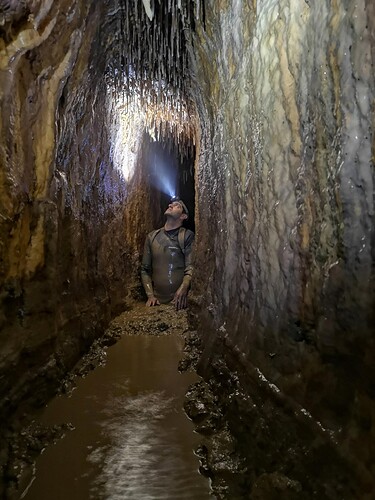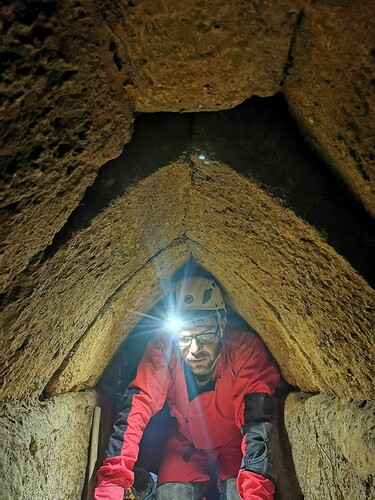Notorious Pontius Pilate Is the One Who Built Jerusalem Aqueduct, Study Finds
The researchers, who collected their data while spelunking into shafts and digging through mud and chilly water, also discovered the aqueduct’s ‘cutting-edge’ method of construction
Open gallery view
A researcher exploring the Biar Aqueduct. Credit: Azriel Yehezkeli
Dec. 19, 2021
New research suggests that the Roman prefect Pontius Pilate is the one that built the Biar Aqueduct, the most sophisticated ancient aqueduct of the Jerusalem area. The study also uncovered the way the unique aqueduct was constructed.
The aqueduct is part of the ancient water system serving Jerusalem. Biar, the shortest of the aqueducts, brought water from a point south of Bethlehem to Solomon’s Pools. Other aqueducts carried the water from there to Jerusalem. The five-kilometer aqueduct includes the Biar Spring, an underground shaft tunnel running about three kilometers, a surface channel and dozens of piers used for its construction and maintenance.
The research was published in the latest edition of the journal Geoarchaeology, and conducted by Azriel Yechezkel of the Institute of Archaeology, Hebrew University of Jerusalem, as part of his doctoral studies, together with Yoav Negev of the Israel Spelunking Club and Hebrew University colleagues Amos Frumkin and Uzi Leibner. The team mapped out 1,200 meters of the tunnel. Much of the data collection was done by “descending into all accessible shafts,” and crawling through the mud and cold water of the tunnel, but the effort paid off for the researchers.
Open gallery view
One of the researchers in an underground tunnel that was part of the Biar Aqueduct, in December.Credit: A researcher exploring the Biar Aqueduct.
The findings they collected from the train indicate an exceptional, “cutting-edge” engineering project. For example, they found that the source of most of the water is not the Biar Spring, but rather groundwater collected along the way that drains into the aqueduct. Thus, the “volume of water measured near the end of the tunnel” the authors write, “is almost seven times the annual average discharge of the Biar spring itself.” Yechezkel explains that on average, the volume goes up by one percent every five meters.
The research found that in the final 500-meter segment of the tunnel, before it emerges above ground, was built from ashlar stones – large stones, hewn chiseled into squares – "with architectural features unique to the Biar aqueduct.” The researchers say this construction attests to particularly high-quality construction. Another example of the innovative engineering is a kind of open tunnel made of large, chiseled stones built in a method not yet found in the Roman Empire at that time.
“Because of concerns that the hewn rock would collapse, the tunnel starts out wide and high,” Yechezkel tells Haaretz. “Afterward, a kind of sleeve for the aqueduct was constructed out of ashlar stones that were brought down through the shafts.” This technology was mentioned in the writings of the Roman architect Vitruvius in the first century B.C.E.
Open gallery view
A researcher exploring the Biar Aqueduct. Credit: Yoav Negev
Archaeologists exploring Jerusalem have known of the aqueduct for a good 150 years. It has been dated from the Hasmonean period, in the second century B.C.E., through Herod to the late Roman period of the second century C.E. Yechezkel’s team used carbon dating of plaster to suggest that the aqueduct was built in the mid-first century C.E., before the destruction of the Second Temple. They believe Pontius Pilate, the Roman prefect from 26/27 C.E. to 36/37 C.E., known for condemning Jesus to death, ordered its construction.
- This used to be one of the greatest cities of ancient Israel
- Israel: Second synagogue found in hometown of Mary Magdalene
- Before Barbie: Why girls played with dolls in the Roman Empire
This dating dovetails with the description of the Roman-era Jewish historian Josephus, who wrote that Pilate used Temple treasury funds to build an aqueduct. “However, the Jews were not pleased with what had been done about this water; and many ten-thousands of the people got together, and made a clamor against him, and insisted that he should leave off that design,” he wrote in “Antiquities of the Jews.”
Open gallery view
A drawing of Pontius Pilate.Credit: Gebhard Fugel
According to Josephus, Pilate expected the uproar and ordered his soldiers to dress up in Jewish garments, hide among the crowd and strike anyone shouting out against him. On his signal, the soldiers “laid upon” the Jews “much greater blows than Pilate had commanded them,” Josephus wrote, “and since the people were unarmed, and were caught by men prepared for what they were about, there were a great number of them slain by this means, and others of them ran away wounded; and thus an end was put to this sedition.” (Book XVIII, Chap. 3:2)
It also bolsters recent arguments by researchers that the Roman representatives ruling Jerusalem after Herod, particularly Pilate, played a decisive role in the city’s development. For example, coins found in digs south of the Western Wall revealed that the wall was completed after Herod’s death.
Open gallery view
The research found that in the final 500-meter segment of the tunnel, before it emerges above ground, was built from ashlar stones.Credit: Azriel Yehezkeli
“The picture of Pilate arising from archaeological findings is very interesting and different from the slandered, violent image described in the written record,” says Dr. Orit Peleg-Barkat, of the Hebrew University’s Institute of Archaeology. “From an archaeological standpoint, it’s clear that Pilate’s administration took care of the development of urban infrastructure – the water supply and the street system.”
The researchers also discovered that the aqueduct was renovated when the city was known as Aelia Capitolina in the second century C.E. They say the aqueduct was renovated throughout history, serving as a source of Solomon’s Pools until a few decades ago.





